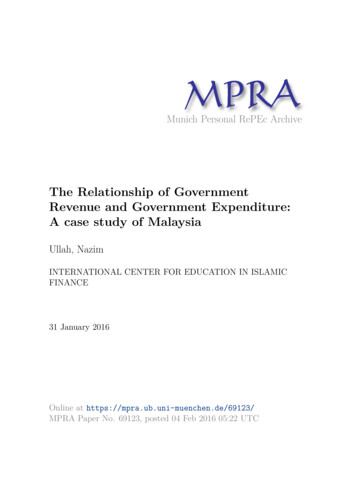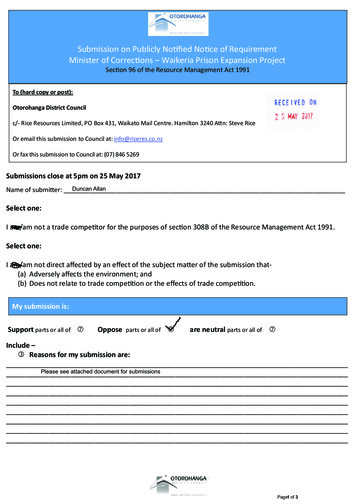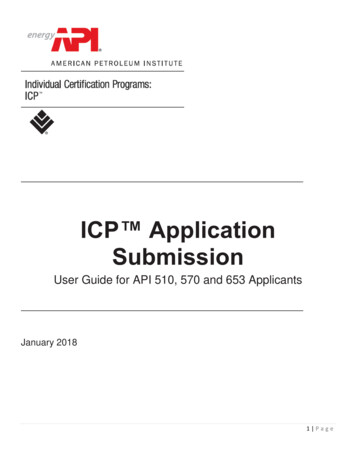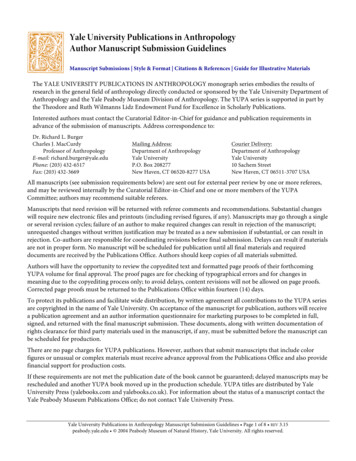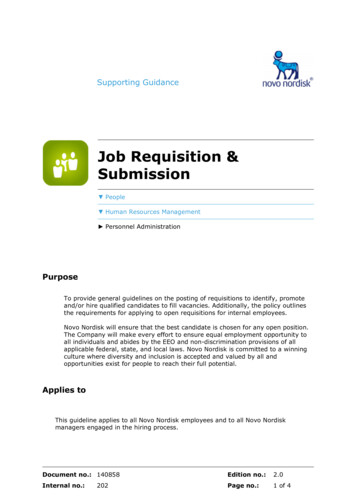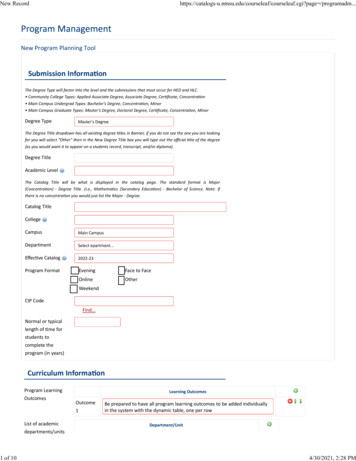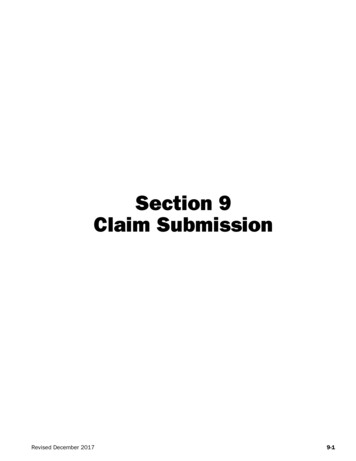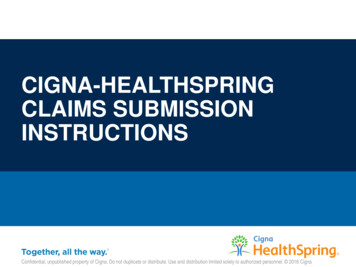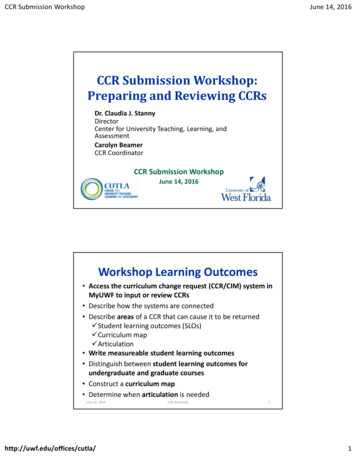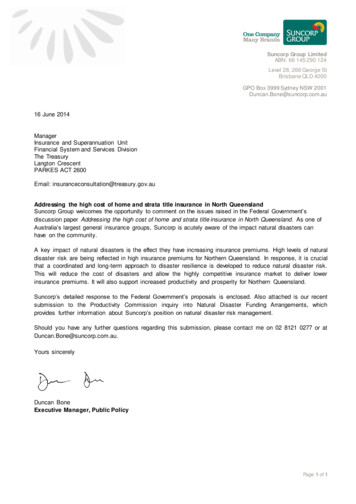
Transcription
Suncorp Group LimitedABN: 66 145 290 124Level 28, 266 George StBrisbane QLD 4000GPO Box 3999 Sydney NSW 2001Duncan.Bone@suncorp.com.au16 June 2014ManagerInsurance and Superannuation UnitFinancial System and Services DivisionThe TreasuryLangton CrescentPARKES ACT 2600Email: insuranceconsultation@treasury.gov.auAddressing the high cost of home and strata title insurance in North QueenslandSuncorp Group welcomes the opportunity to comment on the issues raised in the Federal Government’sdiscussion paper Addressing the high cost of home and strata title insurance in North Queensland. As one ofAustralia’s largest general insurance groups, Suncorp is acutely aware of the impact natural disasters canhave on the community.A key impact of natural disasters is the effect they have increasing insurance premiums. High levels of naturaldisaster risk are being reflected in high insurance premiums for Northern Queensland. In response, it is crucialthat a coordinated and long-term approach to disaster resilience is developed to reduce natural disaster risk.This will reduce the cost of disasters and allow the highly competitive insurance market to deliver lowerinsurance premiums. It will also support increased productivity and prosperity for Northern Queensland.Suncorp’s detailed response to the Federal Government’s proposals is enclosed. Also attached is our recentsubmission to the Productivity Commission inquiry into Natural Disaster Funding Arrangements, whichprovides further information about Suncorp’s position on natural disaster risk management.Should you have any further questions regarding this submission, please contact me on 02 8121 0277 or atDuncan.Bone@suncorp.com.au.Yours sincerelyDuncan BoneExecutive Manager, Public PolicyPage 1 of 1
Addressing the high cost of homeand strata title insurance in NorthQueensland - Discussion PaperSuncorp General Insurance Submission
Executive summarySuncorp Group welcomes the opportunity to comment on the issues raised in theFederal Government’s discussion paper Addressing the high cost of home and stratatitle insurance in North Queensland.Suncorp Insurance has a long and proud history of protecting the Queenslandcommunity from the immediate and severe cost impact of disasters. We look forwardto working with the Queensland and Federal Governments to ensure that we areable to build the resilience of our communities and deliver the insurance ourcustomers need.In Australia, no State population faces a greater risk of natural peril thanQueensland. Within the State, the Northern region faces the greatest exposure interms of both frequency and severity of events and populations at risk, driven largelyby cyclones.As a result, insurance affordability is an issue in North Queensland - as it is in highrisk regions across the world. As the Australian Government Actuary noted in hisinitial examination of strata insurance over the eight years until 2012, for every 100of premium charged insurers paid out 130 on claims and expenses. 1 The stratamarket is only now returning to moderate profit.The role of the industry in response to this issue must be assessing where productdesign and distribution changes may assist in easing affordability pressures for thoseunable to pay premiums for high risk properties while still meeting regulatory,prudential and shareholder needs.Suncorp is currently developing an affordable product for renters in partnership withcommunity services organisation Good Shepherd, having recently signed aMemorandum of Understanding to develop a sustainable and affordable homeproduct targeting those at risk of non-insurance.However the issue is larger than the insurance industry. Australia has a competitiveand contestable insurance industry, characterised by a market that is “largely opento the entry of new insurers, including foreign insurers” with “an intensification ofcompetition and contestability broadly across the general insurance sector in recentyears”2. It is certainly true that at this juncture - “areas such as North Queenslandhave comparatively few[er] insurers prepared to do business in property insurance,1Australian Government Actuary, Report on Investigation into Strata Title Insurance Price Rises in North Queensland, AGA,Canberra, October 2012, p6.2The Department of Treasury, The Department of Treasury's submission to the Financial System Inquiry, The Treasury,Canberra, April 2014, p64.2
due to concerns over storm and cyclone risk.”3 The barrier to competition – as is thecase across other similar areas across the world – is the high level of disaster risk.The only way for the Government to attract competition to the market is to betteraddress the underlying risks and collect more reliable hazard data to reduceuncertainty for consumers and insurers. We believe such investment, along with taxreform to reduce the burden on premium holders, is the key to increasingcompetition and reducing premiums in the long-term.Australia lacks a co-ordinated and long-term approach to better protectingcommunities at high risk of natural disasters. The affordability issues highlighted inthe discussion paper are a clear market signal that this gap must be filled.Experience has shown comprehensive mitigation and resilience programs canreduce home insurance premiums by up to 80 per cent. In St George where a leveehas been completed, anecdotal evidence suggests the subsequent reduction in riskhas attracted more insurers to the area.Economic modelling demonstrates the benefits from this would extend across theaffected communities into the Australian economy. Investing 250 million inmitigation and resilience measures per year over ten years would drive a 6.5 billionincrease in GDP.4By contrast, the proposal to build an aggregator may decrease cover and increasecosts for insurers without stimulating competition or driving premium reductions. Ananalysis of the aggregator heavy UK market suggests aggregators do not placeadditional downward pressure on premiums where risk is the underlying issue, nordo they increase transparency.Suncorp also has serious concerns about softening regulations to attractunauthorised foreign insurers to high risk areas. Such a move would increase therisks being faced by consumers by removing protections, such as the FinancialService Ombudsman. It would also increase the risk of poor product coverage and ofthese insurers defaulting. Ultimately, this would shift the onus onto government tocover any shortfall through additional disaster assistance funding and compound theaffordability issue in the medium to long-term.Suncorp notes many of the questions outlined in the discussion paper are also beinglooked at by the Financial System Inquiry, the Australian Government Actuary, theProductivity Commission inquiry into Natural Disaster Funding and the CompetitionPolicy Review. It may be prudent to await the outcome of these other inquiries which3The Department of Treasury, The Department of Treasury's submission to the Financial System Inquiry, The Treasury,Canberra, April 2014, p64-654KPMG, “Risk Apportionment in the Insurance Sector”, Canberra, March 2014, p3.3
are examining, on a more systemic level, issues around competition and theopportunities provided by technology to better inform consumers.Suncorp overviewOperating some of the country’s most trusted insurance brands, Suncorp is theleading general insurance group in Australia. We offer a range of personal andcommercial insurance products protecting the financial wellbeing of millions ofAustralians. As a Group, Suncorp has around 15,000 employees and has more thannine million customers. In our General Insurance business alone, in 2012-13Suncorp paid out 5.8 billion in insurance claims, averaging more than 15 millioneach day.Suncorp Personal Insurance offers a range of insurance products including car,home and contents, travel, boat, motorcycle and caravan insurance. The key toSuncorp’s success in personal insurance is its portfolio of well-known brands. Theseinclude Suncorp Insurance, AAMI, GIO, Apia, Vero, Shannons, Just Car Insurance,Insure My Ride, Bingle, Terri Scheer, CIL Insurance and Resilium. These brandshave built reputations for insurance innovation, outstanding customer service andtrustworthy products.Supporting communitiesSuncorp works with communities across Queensland on disaster mitigation andresilience projects, providing data and insight to government, community groups anddisaster experts.Suncorp has an ongoing relationship with James Cook University and SouthernQueensland University, working on projects to better understand the risks beingfaced by communities in the region and what could be done to reduce them.We also work with local councils in high risk communities to share our risk data withthem and to assess the effect of mitigation projects on insurance premiums.4
Natural disaster vulnerability in NorthQueenslandHigh risk regionsOver the last few decades, across the globe there have been escalating impacts ofnatural hazards. According to the Institute of Actuaries of Australia, global trendshave shown a significant increase in the frequency of shock events over the pastsixty years as shown in Figure 1. This has been driven by population growth,infrastructure density and domestic migrations to more vulnerable regions. 56FIGURE 1: Number of catastrophes 1980-2012This trend is expected to continue in the future as populations expand into regionshighly susceptible to natural disasters. In a local context, the Business Roundtablefor Disaster Resilience and Safer Communities White Paper noted that by 2050,natural disasters may cost the Australian economy 23 billion a year.7Trends in Queensland insurance claimsQueensland is the State with the most population at the greatest risk of natural perilsin Australia. Within the State, the Northern region faces the greatest vulnerabilitydriven by exposure to cyclones.5KPMG, Risk Apportionment in the Insurance Sector, March 2014, p3.Ibid.7Deloitte Access Economics, Building our nations resilience to natural disasters, June 2013, p10.65
FIGURE 2: Suncorp’s view of natural peril risk across the countryQueensland has a history of a consistently higher levels of claims paid out as aproportion of gross written premiums than other States. The July 2010-June 2013Australian Prudential Regulation Authority (APRA) data shows 90 per cent ofpremium was paid out as claims, more than 10 per cent above the nearest State.This is further evidence that the premiums being charged in North Queenslandreflect the risks in the area.Suncorp’s own claims experience reflect this trend, having paid more than 1 billionin claims to our customers – both catastrophes and other claims - in NorthQueensland over the past five years. Across the industry, since 2006 insurers havepaid out about 3.4 billion in claims through declared catastrophes in NorthQueensland, which currently has an estimated population of just over 700,000.8 Thisonly takes into account the damage caused by declared catastrophes and excludes‘everyday’ claims.8Queensland Department of Communities, Child Safety and Disability Services 2013, accessed on 12 June 2014 d-region 6
Competition in the North QueenslandmarketThe Australian insurance market is competitive and there has been “anintensification of competition and contestability broadly across the general insurancesector in recent years”9.In general, there are relatively low barriers to entry in the domestic insurance market,as evidenced by new entrants such as Youi, Budget Direct and non-traditionalentrants such as Coles and Woolworths. The key existing barriers are Australia’sprudential requirements. Suncorp strongly supports robust prudential regulation andbelieves this is imperative to the stability and security of our financial system andconsumer protection.There is scope to reduce these standards in certain areas where the requirementsare adding cost without consumer benefit, as Suncorp noted in its FSI submission10.Broadly, however, these regulations work well to protect the Australian community.The market is more concentrated in high risk areas, including North Queensland.This was noted by Treasury’s recent submission to the 2014 Financial SystemInquiry which observed that “areas such as North Queensland have comparativelyfew insurers prepared to do business in property insurance, due to concerns overstorm and cyclone risk.”11 The latest Roy Morgan market share data shows that atleast nine separate insurers are operating in North Queensland to varying degrees.A number of parties have called on the Federal Government to take action togenerate more competition in the North Queensland insurance market. Thediscussion paper proposes attracting more foreign insurers into the region. Suncorp,the largest insurer in the region, would welcome further competition from othercompanies on a level playing field.However, Suncorp believes given the key limiting factor to competition in NorthQueensland is the high level of risk in the region, limiting the returns being generatedon the capital needed to provide cover. This last point is partly evident in the APRAdata in the discussion paper, which show a much higher proportion of claimscompared to premium collected paid out within Queensland than other Australianstates, confirmed by both the recent AGA reports into strata title insurance.9The Department of Treasury, The Department of Treasury's submission to the Financial System Inquiry, The Treasury,Canberra, April 2014, p64.10Suncorp General Insurance, Submission to the Financial System Inquiry, March 2014.11The Department of Treasury, The Department of Treasury's submission to the Financial System Inquiry, The Treasury,Canberra, April 2014, p657
Suncorp firmly believes that the only way to encourage more insurers to compete inNorth Queensland is to either wait until more authorised insurers view the market asattractive or by reducing the risk. The only way to reduce risk and its associatedcosts is to invest in mitigation and resilience programs that limit exposure and reducevulnerability.Other means of reducing premiums inNorth QueenslandInsurance product responsesSuncorp is currently working with community services organisation Good ShepherdMicrofinance on developing an affordable product for high risk renters. Amemorandum of understanding has also been signed to develop a sustainable lowercoverage, but more affordable, home insurance product targeting those at risk ofnon-insurance.Suncorp is working with Good Shepherd Microfinance to ensure due diligence isapplied to the operation of these products and that the trade-off between coverageand premium is appropriate. Regardless, while such innovations will assist certainconsumers they will not address the underlying issue of communities at high risk thatis being highlighted by the premium price signal discussed within the paper.Implement tax recommendationsInsurance taxes, duties and levies currently form a significant barrier againstAustralians purchasing affordable insurance cover. Insurance premiums arecurrently subject to the imposition of multiple taxes, with the Australian Bureau ofStatistics reporting that insurance taxes contributed 5.39 billion in taxation revenueacross all levels of government in 2011-12. In 2011-12 in Queensland, insurancetaxes accounted for 563m of the Budget, representing about 4 per cent of total taxrevenue for the State.The need for insurance tax reform is particularly clear when taxation revenue growthis considered. Insurance taxes are applied as a percentage of premiums meaningthat as premiums increase due to extreme weather costs and capital requirements,additional taxes are collected from the community. In Queensland, when combinedwith the GST, this tax impost adds up to around 20 per cent of all insurancepremiums, proportionally burdening those at high risk substantially more than otherthe majority of consumers.Suncorp strongly supports recommendation 79 of Australia’s Future Tax Systemwhich recommends that, “[a]ll specific taxes on insurance products, including the fire8
services levy, should be abolished.”12 In Queensland, we recommend the StateGovernment immediately look to reduce the stamp duty collected on householdinsurance.Investing in mitigation and resilienceSuncorp believes there is a strong role for all levels of Government to promoteresilience both in North Queensland and across other high risk regions in Australia.Risk is driven by a combination of vulnerability and exposure. There are numerousopportunities to enhance resilience acting these elements. Some areas forexploration are outlined below. More detail can be found in Suncorp’s submission tothe Productivity Commission’s review of disaster funding or our previous RiskyBusiness paper, which has been included as in the appendix to this submission.Better natural peril dataIt is vital that better, centralised hazard data is collected to share directly withconsumers to better inform their decisions and with insurers to allow insurers to moreaccurate risk pricing. More accurate data is likely to allow more competition in theinsurance market but reducing uncertainty for insurers who do not have a claimshistory in the area.Economic benefits beyond premiumsAppropriate mitigation and resilience does not simply reduce premiums. Addressingthe underlying risk communities face have much broader social and economicbenefits. KPMG’s study into risk apportionment in the insurance sector,commissioned by Suncorp, examined the economic effects of investing in mitigationacross Australia13. The study found a structured mitigation provides a GDP boostfelt across household consumption, exports and imports, with a lower need forinvestment capital and returns due a reduction in rebuilding activity. This means thatinvesting 2.5 billion in mitigation and resilience over ten years would not just reducehigh premiums across the country, but also drive a 6.5 billion increase in GDP.Limiting exposureA key element of mitigating natural disaster risk is limiting exposure to naturalhazards in the first place. An effective way of limiting exposure is land-use planning.Our expanding built environment creates a clear need for risk-informed urbanplanning that helps to manage exposure to natural hazard risks. This was highlightedin the National Strategy for Disaster Resilience, which states:1213Australia’s Future Tax System Review , Final Report: Part 2: Detailed Analysis – Volume 2, Canberra, 2010, p474.KPMG, Risk Apportionment in the Insurance Sector , March 2014, p3.9
The strategic planning system is particularly important in contributing to thecreation of safer and sustain-able communities. Locating new or expandingexisting settlements and infrastructure in areas exposed to unreasonable riskis irresponsible.14Accounting for risk in the planning process is crucial for ensuring that newdevelopments are exposed to acceptable levels of personal and financial risk. Whilecyclone risk is less localised than say bushfire, planning decisions can still reduceassociated risks storm surge, flooding and other effects.Mitigation and resilience programsThe most effective lever to reduce vulnerability to natural disasters like cyclones isincreasing resilience. The Productivity Commission has recognised the importanceof mitigation in reducing insurance premiums, concluding that “increasedgovernment spending on disaster-mitigation infrastructure could reduce insurancepremiums as well as the total economic impact of disasters.”15Over the course of the past few decades, a number of examples have shown theimportance mitigation and resilience can play in reducing the impact and costs ofnatural disasters on Australian communities. Following the devastation of CycloneTracy in 1974, disaster wind resistance standards were significantly i
Suncorp Personal Insurance offers a range of insurance products including car, home and contents, travel, boat, motorcycle and caravan insurance. The key to Suncorp’s success in personal insurance is its portfolio of well-known brands. These include Suncorp Insurance, AAMI, GIO, Apia, Vero, Shannons, Just Car Insurance,
